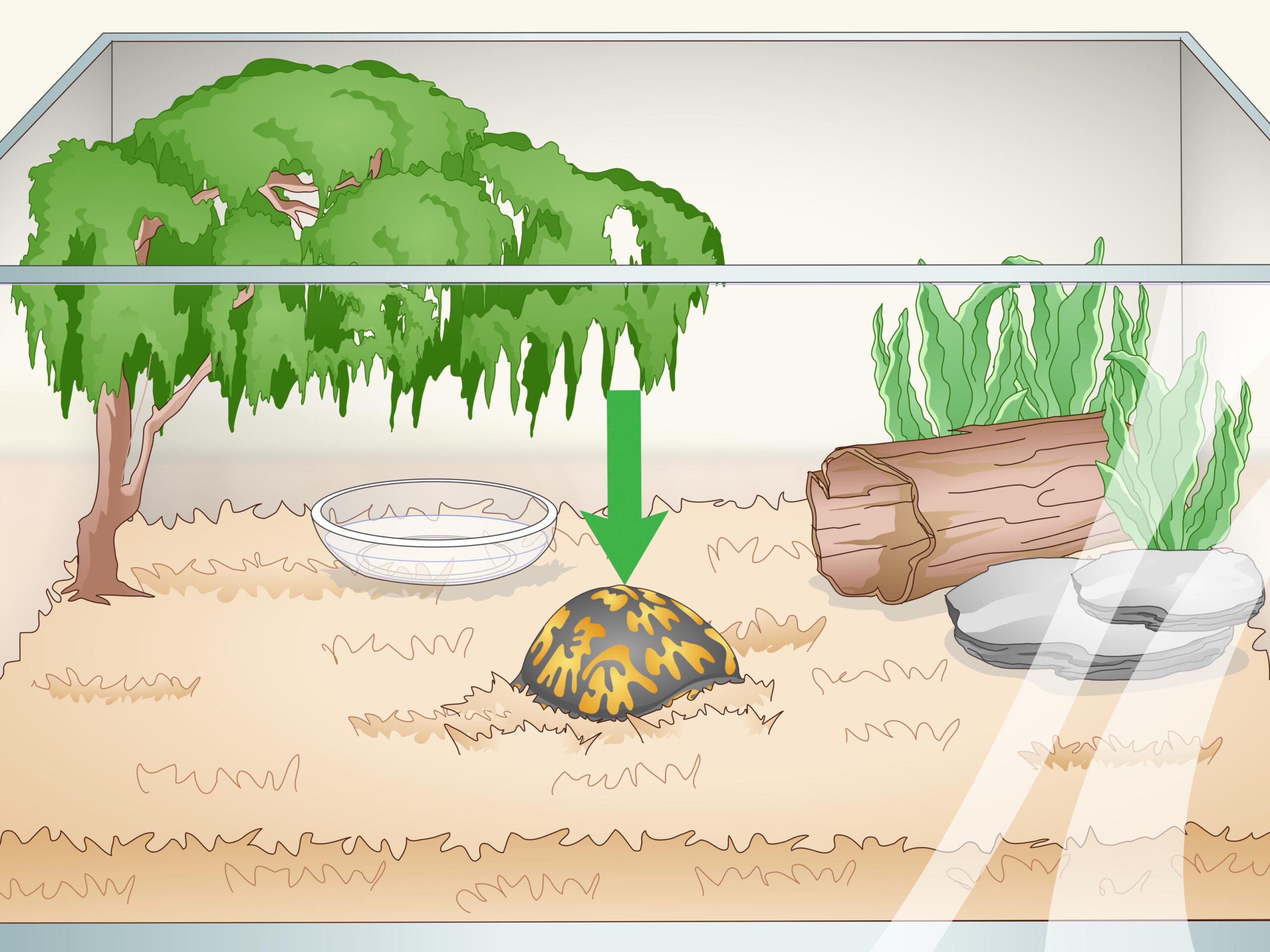To care for an Eastern Box Turtle, provide a suitable habitat with proper temperature, humidity, and hiding spots. Ensure a balanced diet of insects, fruits, and vegetables to maintain their health and well-being.
Eastern Box Turtles are fascinating reptiles that make unique pets. Their striking appearance and interesting behaviors make them a popular choice among reptile enthusiasts. In this guide, we will explore the essential aspects of caring for an Eastern Box Turtle to ensure they thrive in captivity.
From setting up their habitat to feeding them a nutritious diet, we will cover all the necessary steps to keep your Eastern Box Turtle happy and healthy. Let’s dive into the world of Eastern Box Turtle care and discover how to provide the best possible environment for these amazing creatures.
Setting Up The Habitat
Setting up the habitat for your Eastern box turtle is essential for ensuring its health and well-being. By creating a suitable environment, you can mimic the turtle’s natural habitat and provide the necessary conditions for it to thrive. Here are the key factors to consider when setting up the habitat:
Enclosure Size And Type
Eastern box turtles require a spacious enclosure to move around freely. A minimum size of 4 feet by 4 feet is recommended to accommodate their active nature. The enclosure should have a secure lid to prevent escapes and protect the turtle from predators.
Substrate And Temperature Needs
The substrate in the enclosure should consist of a mix of topsoil, coconut coir, and sphagnum moss to create a suitable digging surface. Maintain the temperature between 75-85°F on one side of the enclosure and provide a cooler area around 70°F on the other side to allow the turtle to regulate its body temperature effectively.
Hiding Spots And Water Source
Include various hiding spots such as half logs, rocks, and plants to offer security and shelter for the turtle. A shallow water dish should be provided for drinking and soaking, ensuring it is not too deep to avoid drowning.
:strip_icc()/box-turtles-as-pets-1237255-FINAL-5b9bcdb04cedfd00506dc033.png)
Credit: www.thesprucepets.com
Feeding And Diet
To properly care for an Eastern Box Turtle, it’s important to provide a balanced diet consisting of both animal and plant-based foods. This can include insects, worms, fruits, and leafy greens. It’s also essential to ensure they have access to clean water at all times.
Eastern box turtles are omnivorous, and their diet should consist of a variety of foods that are high in calcium and low in phosphorus. The right diet can help your turtle grow healthy and strong, and prevent diseases. In this section, we will discuss the natural diet of Eastern box turtles, commercial turtle diets, and supplements and treats that can be added to their diet to provide additional nutrients.Natural Diet
Eastern box turtles in the wild eat a variety of foods, including insects, earthworms, snails, slugs, fruit, berries, and vegetation. They are opportunistic feeders and will eat almost anything that they can find. Insects are an essential part of their diet, as they are a good source of protein. Earthworms are also a good source of protein and are high in calcium. Fruits and berries are a good source of vitamins and minerals, while vegetation provides fiber.Commercial Turtle Diets
Commercial turtle diets can be a convenient way to provide your Eastern box turtle with a balanced diet. These diets typically consist of pellets or blocks that are formulated to provide the necessary nutrients for your turtle. However, it is important to choose a high-quality commercial diet that is made specifically for box turtles, as some commercial diets may not provide all of the necessary nutrients. It is also important to supplement the commercial diet with fresh fruits and vegetables.Supplements And Treats
Supplements and treats can be added to your Eastern box turtle’s diet to provide additional nutrients. Calcium supplements are especially important, as they can help prevent metabolic bone disease. You can also offer your turtle treats such as mealworms, waxworms, and crickets, but these should be offered in moderation as they are high in fat. Fruits such as strawberries, raspberries, and blueberries can be offered as treats, but again, should be given in moderation due to their high sugar content. In conclusion, providing your Eastern box turtle with a balanced diet that consists of a variety of foods is essential to its health and well-being. A combination of natural foods, commercial diets, and supplements and treats can help ensure that your turtle receives all of the necessary nutrients.Handling And Interaction
When it comes to caring for an Eastern box turtle, handling and interaction play a crucial role in building a bond with your pet. Proper handling techniques and bonding activities are essential for ensuring the well-being of your turtle. Let’s delve into these aspects to understand how to establish a positive relationship with your Eastern box turtle.
Proper Handling Techniques
When handling your Eastern box turtle, it’s important to approach with gentle movements and avoid sudden actions. Always support the turtle’s body with both hands to prevent any stress or injury. Be mindful of the turtle’s comfort and never force it to interact if it seems agitated or withdrawn. Additionally, ensure your hands are clean to avoid transferring harmful bacteria.
Bonding With Your Turtle
Bonding with your Eastern box turtle involves creating a safe and enriching environment where the turtle feels secure. Spend time near the turtle’s habitat, speaking softly and offering food by hand to establish trust. Engage in activities such as gentle stroking or shell scratching to familiarize your turtle with positive human interaction. Building a bond takes time and patience, so allow the turtle to approach you at its own pace.

Credit: www.wikihow.com
Health And Wellness
When it comes to caring for an Eastern box turtle, ensuring their health and wellness is crucial. By being attentive to their needs and proactive in maintaining their well-being, you can help your turtle thrive. In this section, we will explore signs of illness, the importance of regular vet check-ups, and tips for keeping your turtle healthy.
Signs Of Illness
It’s essential to be vigilant for any signs of illness in your Eastern box turtle. Common indicators of health issues include loss of appetite, lethargy, shell abnormalities, abnormal discharge, and labored breathing. If you notice any of these symptoms, it’s vital to seek prompt veterinary care to address any potential health concerns.
Regular Vet Check-ups
Regular visits to a reptile-savvy veterinarian are crucial for maintaining your Eastern box turtle’s health. Scheduled check-ups allow the vet to assess your turtle’s overall condition, address any concerns, and provide necessary preventive care. These check-ups can help detect health issues early, leading to better outcomes for your turtle.
Keeping The Turtle Healthy
To ensure your Eastern box turtle’s well-being, it’s important to provide a balanced diet consisting of leafy greens, vegetables, fruits, and occasional protein sources such as insects or worms. Maintaining proper temperature and humidity levels in their habitat is essential for their health. Additionally, regular cleaning and maintenance of their enclosure is crucial in preventing illness and promoting a healthy environment.
Reproduction And Breeding
Reproduction and breeding are crucial aspects of caring for an Eastern box turtle. Understanding their mating behavior, nesting, and egg incubation process is essential for their well-being and successful breeding. Here’s a closer look at these key aspects:
Mating Behavior
Eastern box turtles typically mate in the spring and early summer. The male displays courtship behaviors, including head bobbing and circling the female. Once the female is receptive, mating occurs, and fertilization takes place internally.
Nesting And Egg Incubation
After mating, the female Eastern box turtle seeks out a suitable nesting site. She digs a shallow hole using her hind legs and lays a clutch of eggs. It’s important to provide a suitable nesting area in captivity to mimic their natural environment.
Legal Considerations
When caring for an Eastern box turtle, it’s crucial to be aware of the legal considerations that come with owning and caring for these reptiles. Understanding the permits and regulations involved, as well as how to handle rescued turtles, is essential for ensuring the well-being of these fascinating creatures.
Permits And Regulations
Before acquiring an Eastern box turtle, check with local authorities about the permits and regulations required for keeping one as a pet. Many regions have specific rules regarding the possession and care of native wildlife, including box turtles. It’s important to comply with these regulations to avoid legal issues and ensure the welfare of the turtle.
Rescued Turtles
In the case of rescued turtles, it’s important to contact wildlife rehabilitators or local animal control agencies. They can provide guidance on how to properly care for the turtle and may also be able to assist in finding a suitable permanent home for the animal if necessary. Never release a rescued turtle back into the wild without proper authorization, as this can have negative consequences for the local ecosystem.

Credit: reptilesmagazine.com
Conclusion
Caring for an Eastern Box Turtle involves creating a suitable habitat, providing proper nutrition, and ensuring regular veterinary check-ups. By following these guidelines, you can help your turtle thrive in a healthy and happy environment. Remember, their well-being is in your hands.
Practice responsible pet ownership always.






Leave a Reply